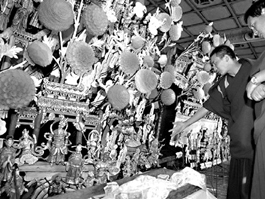
Tibetan New Year, Losar, falls on February 28, and Tibetans
across the country have started preparing for the celebrations.
They whitewash houses, clean silver and bronze wares, and paint
good omens on beams and pillars.
To Tibetans living in northwest China's Qinghai Province, their
warm-up for the celebration has started even earlier this year, as
they could go to Tar Monastery for its annual display of butter
sculptures which started on February 12.
The monastery has been famous for its three representative arts:
butter sculpture, fresco and duisui embroidery.
The festival attracts 100,000 locals and tourists each year, but
elder lamas in the monastery worry that this tradition, which has
lasted some 400 years, is endangered as fewer and fewer young lamas
are willing to learn the complicated art.
Butter sculpture originated from Tibet and was introduced to the
Tar Monastery, also known as Kumbum Monastery, in the early 17th
century. Many monasteries in China make butter sculptures, but
those of Tar excel in technique and scale.
Long history
Legend says that in 641, when Princess Wencheng arrived in Lhasa
to marry Songtsen Gampo (born circa 609-613 and died 650), king of
Tubo, she brought a statue in the shape of Sakyamuni, founder of
Buddhism.
Following the Buddhist tradition, flowers must be offered as a
tribute to the Buddha statue. But it was deep winter and no fresh
flowers could be found. So people made a bunch of flowers with
butter as an offering.
In 1409, Tsongkhapa (1357-1419), founder of the Gelug Sect of
Tibetan Buddhism, who was born in today's Huangzhong County where
the Tar Monastery was founded, held the Grand Sermons Ceremony in
Lhasa.
He dreamed of thorny bushes turning into bright lanterns, weeds
bursting into blossom amid numerous shiny treasures.
When he woke up, the great master immediately asked his
followers to make the treasures and flowers as he had dreamed and
offered them to the Buddha.
With pure yak and goat milk butter as the raw material, the
sculptures are painted with mineral dyestuff. Often the sculptures
are part of a series which depict a story, such as the life of
Sakyamuni.
As the butter sculpture art entered the Tar Monastery in 1603,
two academies devoted to its creation and study have been
established. Every year, when the Grand Sermons Ceremony is held
here during the Lantern Festival, the two academies bring out their
best works.
This year, the butter sculptures in the monastery featured two
stories: Tara, the most beloved female deity of Tibetan Buddhism,
saves humans from eight calamities; the Indian prince brothers
Donyo and Dondrup overcome all sorts of troubles with their
fraternity to become kings.
Like previous years, the grand display drew some 100,000 locals
and tourists. Some local farmers went to the monastery in the
morning just to wait for the display, which would begin at
night.
Under the lanterns, the protagonists of the stories appeared
alive among the delicate flowers and woods, mountains and
architectures. Buddhist believers throng to the sculptures to offer
tributes for good luck in the coming year.
Daunting task
For the visitors, the colourful and fragrant sculptures look as
glorious as ever. But the lamas of the monastery feel their works
are not as good as before.
In the past, the elderly lamas would lead the younger students
to create new works featuring fresh technique each year, according
to Rabgye Gyaltsen, a 41-year-old lama specializing in making
butter sculptures.
But as the older generation passed away, the middle-aged and
younger lamas have only been able to following the old rules
strictly. Making breakthroughs has been very difficult, said
Gyaltsen.
In addition, very few lamas have shown the willingness to learn
the technique. The lack of young students will surely hinder the
future development of this ancient art.
Shakabri, a lama with the monastery, said there are less than 40
lamas specializing in butter sculpture. But in the past, the two
academies once had over 100 lamas working on the butter
sculptures.
Shakabri and Gyaltsen explain that as the elderly lamas passed
away, the present lamas have yet to fully understand the ancient
art before they can make creations easily. The young novices also
have few teachers to turn to when they have questions.
On the other hand, the making of butter sculpture is itself a
daunting task. As butter made from yak or goat milk melts in warm
weather, butter sculpture has to be made in the coldest months of
the year.
To sculpt butter, lamas must dip their hands in icy water. Only
with numb hands can they begin the sculpting.
Over the past centuries, the art of butter sculpture has become
very specialized: Making people, animals and flowers has each
become a tradition requiring different techniques.
In sub-zero temperature rooms, the elderly lamas and their
students first prepare the frame of sculpture with bamboo sticks,
ropes and others. Then they mix old butter sculptures with wheat
ashes to form black mud, which is used to make the primitive body
of the sculptures.
After modifying the base, the lamas will apply colourful butter
onto it. The figurines are outlined with gold and silver powder.
Finally the small parts are fixed onto the frame with iron
wire.
As the creation lasts some three months in winter, many lamas
have found their fingers deformed when a grand display is
prepared.
The administration committee of the Tar Monastery, where
Shakabri is a member, is trying to improve the skills of the lamas
and attract more novices. One of the measures is to hold a contest
of butter sculptures made by the two academies.
In addition, the Tar Monastery is applying to list its butter
sculpture as an intangible cultural heritage of the United Nations
Educational, Scientific and Cultural Organization. With more
people's attention, it is hoped that the beautiful flowers of
butter sculpture will melt people's hearts, rather than melt
away.
(China Daily February 21, 2006)

